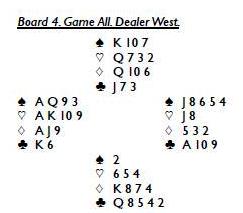The World Wide Bridge Contest is a long-standing tournament in the World Bridge Federation’s calendar, 2013 is its 27th year, and I do hope you all enjoyed this event and found the hands interesting and challenging – my thanks go to Eric Kokish for his excellent and most entertaining commenta ry. Gianarrigo Rona, President, World Bridge Federation.
ry. Gianarrigo Rona, President, World Bridge Federation.
West will open 2NT or start with a strong artificial opening. N/S will not participate in the auction, regardless, and virtually every E/W pair will find a route to 4![]() , more often than not from the West side after a transfer sequence. The best lead for the defense is a diamond because it puts some pressure on declarer should he do the wrong thing in hearts. However, most Norths will lead something else: a heart is clearly worst as it gives declarer 11 top tricks after knocking out the
, more often than not from the West side after a transfer sequence. The best lead for the defense is a diamond because it puts some pressure on declarer should he do the wrong thing in hearts. However, most Norths will lead something else: a heart is clearly worst as it gives declarer 11 top tricks after knocking out the ![]() K.
K.
Declarer has several options on a low club lead. He could play the nine and take the queen with the ace, then finesse the ![]() 10 on the way back to discard a diamond and be in the right hand to lead trumps toward his ace-queen. Consider, however, that playing clubs for three tricks will not help declarer to come to 12 tricks: to achieve that total, declarer must run the
10 on the way back to discard a diamond and be in the right hand to lead trumps toward his ace-queen. Consider, however, that playing clubs for three tricks will not help declarer to come to 12 tricks: to achieve that total, declarer must run the ![]() J, playing South for the queen. To this end, declarer would have to risk holding himself to just 10 tricks if North has led a diamond or switched to diamonds after winning the
J, playing South for the queen. To this end, declarer would have to risk holding himself to just 10 tricks if North has led a diamond or switched to diamonds after winning the ![]() K (but, as the
K (but, as the ![]() J would be guarded, the contract would be safe even if the
J would be guarded, the contract would be safe even if the ![]() J were to lose to the queen). As the third club winner is not vital for declarer, he might elect to win the
J were to lose to the queen). As the third club winner is not vital for declarer, he might elect to win the ![]() A to lead a trump to the queen. North make a good play by ducking painlessly. When declarer cashes the ace, he no longer has a third-round trump entry to dummy so if he wants to play South for the
A to lead a trump to the queen. North make a good play by ducking painlessly. When declarer cashes the ace, he no longer has a third-round trump entry to dummy so if he wants to play South for the ![]() Q he will need to use a fourth round of trumps to get there and in the process lose a club ruff in the West hand. In effect, he forces himself to play North for the
Q he will need to use a fourth round of trumps to get there and in the process lose a club ruff in the West hand. In effect, he forces himself to play North for the ![]() Q, but must still lose a diamond as he has only four spade tricks, three hearts, the
Q, but must still lose a diamond as he has only four spade tricks, three hearts, the ![]() A, two clubs and a club ruff in the short-trump hand.
A, two clubs and a club ruff in the short-trump hand.
Alternatively, declarer could win the ![]() A and pass the
A and pass the ![]() J immediately, effectively giving up on Kx of trumps in South or singleton ten in North. That line has considerable appeal as it offers the best chance for the maximum, but it also risks making the minimum. Declarer can still come to 11 tricks if North wins the
J immediately, effectively giving up on Kx of trumps in South or singleton ten in North. That line has considerable appeal as it offers the best chance for the maximum, but it also risks making the minimum. Declarer can still come to 11 tricks if North wins the ![]() Q and switches to a diamond to the king and ace; he must cash the
Q and switches to a diamond to the king and ace; he must cash the ![]() A and revert to hearts, discarding both diamonds from West as neither opponent can ruff. That is not as double-dummy as it might seem as (a) the
A and revert to hearts, discarding both diamonds from West as neither opponent can ruff. That is not as double-dummy as it might seem as (a) the ![]() A might drop the king; (b) an opponent with three hearts might have been dealt king-low of trumps; (c) the same hand has four hearts and the two remaining spades.
A might drop the king; (b) an opponent with three hearts might have been dealt king-low of trumps; (c) the same hand has four hearts and the two remaining spades.
Where East declares, South might lead a diamond on the theory that he needs less from North to build a trick or two. Now declarer has serious immediate concerns as he could go down if he takes a first-round heart finesse through South.
Most will not take that risk and either play on trumps and lose two diamonds and the ![]() K, or play ace-king-ten of hearts, intending to discard a diamond if the queen does not appear. If North covers the
K, or play ace-king-ten of hearts, intending to discard a diamond if the queen does not appear. If North covers the ![]() 10, declarer again faces a decision.
10, declarer again faces a decision.
Should he lead a spade to the queen and risk going down if it loses and North can cash diamonds and play another heart, forcing declarer to guess the trump position; or should he lead a spade to the ace and play the winning heart, guaranteeing the contract with the chance for an overtrick as described in the previous paragraph?
Esta entrada también está disponible en: Spanish

